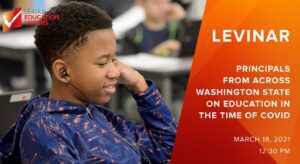Recap: Washington state Principals on Education in the Time of COVID
By Lizzeth Mancilla
Engagement and Policy Intern

In this webinar, we partnered with the Association of Washington School Principals (AWSP) to assemble a panel of principals from across Washington state to discuss how the 2020-21 school year is going, how they would reimagine education based on what they have learned from this unprecedented school year, and how principals can be better supported at the state and district levels. They also answered your questions.
Panelists included:
- Jason Smith, Rogers High School, Puyallup School District
- Tricia Kannberg, Regal Elementary School, Spokane Public Schools
- Carlos Gonzalez, McFarland Middle School, Othello School District
- Nathan Plummer, Sultan Middle School, Sultan School District
- Cindy Cromwell, Kelso Virtual Academy, Kelso School District
- John Belcher, Mount Si High School, Snoqualmie School District
- Justin Hendrickson, South Shore PreK-8, Seattle Public Schools